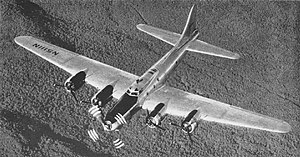Pratt & Whitney T34
| T34 Turbo-Wasp | |
|---|---|

| |
| A B-17 Flying Fortress testbed for the T-34 tuboprop engine. This aircraft was later flown on airshow circuits as the "Liberty Belle".[1] | |
| Type | Turboprop |
| National origin | United States |
| Manufacturer | Pratt & Whitney |
| First run | ca. 1950 |
| Major applications | C-133 Cargomaster |
The Pratt & Whitney T34 (company designation PT2) was an axial flow[2] turboprop engine designed and built by Pratt & Whitney. Its model name was Turbo-Wasp.[2]
Design and development
In 1945 the United States Navy funded the development of a turboprop engine. The T34 was produced from 1951 to 1960, but never used in a U.S. Navy aircraft production.[3]
The YT34 engine with 3 wide-bladed propellers was made for two Navy Lockheed R7V-2 Constellation(C-121s) variants, for testing. Flight tests were 1 September 1954.[4]
In September 1950, a testbed Boeing B-17 Flying Fortress flew with a T34 turboprop mounted in the nose of the bomber. The first application for the T34 was the Boeing YC-97J Stratofreighter, which later became the Aero Spacelines Super Guppy. The next application for the engine was the Douglas C-133 Cargomaster.[3]
Variants

- YT34-P-5
- 5,229 hp (3,900 kW; 5,200 shp)[5]
- YT34-P-12A
- 5,500 hp (4,101.35 kW)[6]
- T34-P-3
- 6,000 hp (4469 kW)
- T34-P-6
- 5,531 hp (4,120 kW; 5,500 shp)[7]
- T34-P-7W
- 7,100 hp (5288 kW) w/water injection
- T34-P-9W
- 7,500 hp (5586 kW) w/water injection
- PT2F-1
- 5,500 hp (4,101.35 kW); Unbuilt civilian version planned to power the Lockheed L-1249B.[8]
- PT2G-3
- 5,600 hp (4,200 kW); Unbuilt civilian version planned to power the Lockheed L-1449 and possibly the L-1549.[8]
Applications

- Aero Spacelines Super Guppy
- Boeing YC-97J Stratotanker (YT34-P-5)[5]
- Lockheed R7V-2 Constellation (YT34-P-12A)[6]
- Lockheed YC-121F Constellation (T34-P-6)[7]
- Douglas YC-124B Globemaster II[9]
- Douglas C-133 Cargomaster
Engines on display
- T34-P-3: National Air and Space Museum[10] (NASM)
- T34-P-7W: NASM[10]
- T34-P-7WA: Pacific Coast Air Museum (PCAM)
Specifications (T34-P3)
Data from Jane's All The World's Aircraft 1961–62[11]
General characteristics
- Type: Turboprop
- Length: 156.8 in (3,983 mm)
- Diameter: 33.75 in (857 mm)
- Dry weight: 2,590 lb (1,175 kg)
Components
- Compressor: 13-stage axial compressor
- Combustors: annular combustion chamber with eight flame tubes
- Turbine: 3-stage axial flow
- Fuel type: JP-4
- Oil system: closed circuit
Performance
- Maximum power output: 5,500 shp (4,103 kW) plus 1,1250 lbf (5.57 kN) thrust, 6,000 ehp (4,476 kW) (take-off power)
- Overall pressure ratio: 6.7:1
- Power-to-weight ratio: 2.32 ehp/lb
See also
Comparable engines
Related lists
References
- ^ warbird registry.org - B-17G/44-85734; Retrieved 6/21/11
- ^ a b Flight Global: 1952 Archive
- ^ a b Pratt&Whitney: T34 Turboprop
- ^ Google Books: Lockheed secret projects: Inside the Skunk Works By Dennis R. Jenkins; p.28-29
- ^ a b alternatewars.com - YC-97 Characteristics Summary; Retrieved 10/12/11
- ^ a b Breffort, Dominique. Lockheed Constellation: from Excalibur to Starliner Civilian and Military Variants. Paris: Histoire and Collecions, 2006. p. 134 Cite error: The named reference "Dom" was defined multiple times with different content (see the help page).
- ^ a b alternatewars.com - YC-121F Charactaristics Summary; Retrieved 11/6/11
- ^ a b Breffort, Dominique. Lockheed Constellation: from Excalibur to Starliner Civilian and Military Variants. Histoire and Collecions, 2006. p. 113
- ^ US War Plane: Post WWII Aircraft Engine Guide
- ^ a b Engine History: NASM Storage
- ^ Taylor 1961, pp. 513–515.
- Gunston, Bill (2006). World Encyclopedia of Aero Engines, 5th Edition. Phoenix Mill, Gloucestershire, England, UK: Sutton Publishing Limited. p. 79. ISBN 0-7509-4479-X.
{{cite book}}: Cite has empty unknown parameter:|coauthors=(help) - Taylor, John W. R. (1961). Jane's All The World's Aircraft 1961–62. London: Sampson Low, Marston & Company.
- Breffort, Dominique (2006). Lockheed Constellation: from Excalibur to Starliner Civilian and Military Variants. Paris: Histoire and Collecions. p. 176. ISBN 2-915239-62-2.
